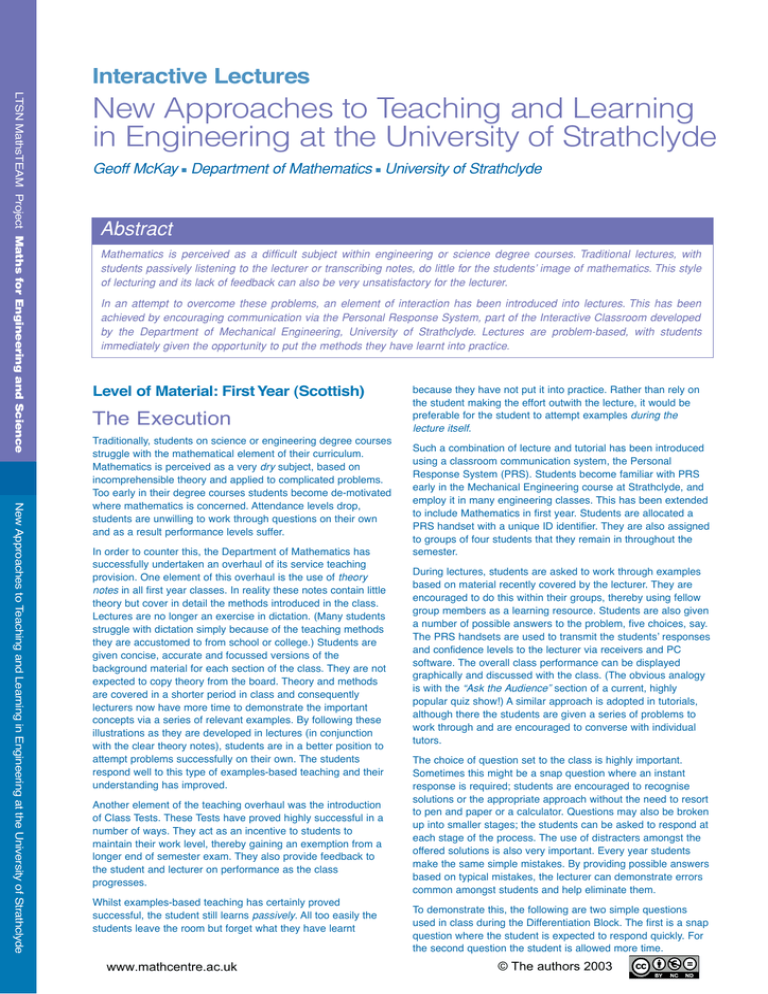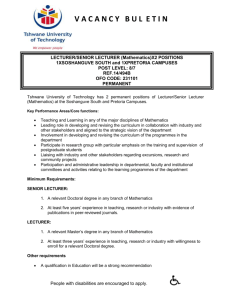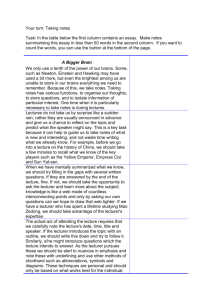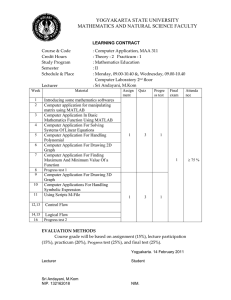Abstract
advertisement

Interactive Lectures LTSN MathsTEAM Project Maths for Engineering and Science New Approaches to Teaching and Learning in Engineering at the University of Strathclyde Geoff McKay ■ Department of Mathematics ■ University of Strathclyde Abstract Mathematics is perceived as a difficult subject within engineering or science degree courses. Traditional lectures, with students passively listening to the lecturer or transcribing notes, do little for the students’ image of mathematics. This style of lecturing and its lack of feedback can also be very unsatisfactory for the lecturer. In an attempt to overcome these problems, an element of interaction has been introduced into lectures. This has been achieved by encouraging communication via the Personal Response System, part of the Interactive Classroom developed by the Department of Mechanical Engineering, University of Strathclyde. Lectures are problem-based, with students immediately given the opportunity to put the methods they have learnt into practice. Level of Material: First Year (Scottish) The Execution New Approaches to Teaching and Learning in Engineering at the University of Strathclyde Traditionally, students on science or engineering degree courses struggle with the mathematical element of their curriculum. Mathematics is perceived as a very dry subject, based on incomprehensible theory and applied to complicated problems. Too early in their degree courses students become de-motivated where mathematics is concerned. Attendance levels drop, students are unwilling to work through questions on their own and as a result performance levels suffer. In order to counter this, the Department of Mathematics has successfully undertaken an overhaul of its service teaching provision. One element of this overhaul is the use of theory notes in all first year classes. In reality these notes contain little theory but cover in detail the methods introduced in the class. Lectures are no longer an exercise in dictation. (Many students struggle with dictation simply because of the teaching methods they are accustomed to from school or college.) Students are given concise, accurate and focussed versions of the background material for each section of the class. They are not expected to copy theory from the board. Theory and methods are covered in a shorter period in class and consequently lecturers now have more time to demonstrate the important concepts via a series of relevant examples. By following these illustrations as they are developed in lectures (in conjunction with the clear theory notes), students are in a better position to attempt problems successfully on their own. The students respond well to this type of examples-based teaching and their understanding has improved. Another element of the teaching overhaul was the introduction of Class Tests. These Tests have proved highly successful in a number of ways. They act as an incentive to students to maintain their work level, thereby gaining an exemption from a longer end of semester exam. They also provide feedback to the student and lecturer on performance as the class progresses. Whilst examples-based teaching has certainly proved successful, the student still learns passively. All too easily the students leave the room but forget what they have learnt www.mathcentre.ac.uk because they have not put it into practice. Rather than rely on the student making the effort outwith the lecture, it would be preferable for the student to attempt examples during the lecture itself. Such a combination of lecture and tutorial has been introduced using a classroom communication system, the Personal Response System (PRS). Students become familiar with PRS early in the Mechanical Engineering course at Strathclyde, and employ it in many engineering classes. This has been extended to include Mathematics in first year. Students are allocated a PRS handset with a unique ID identifier. They are also assigned to groups of four students that they remain in throughout the semester. During lectures, students are asked to work through examples based on material recently covered by the lecturer. They are encouraged to do this within their groups, thereby using fellow group members as a learning resource. Students are also given a number of possible answers to the problem, five choices, say. The PRS handsets are used to transmit the students’ responses and confidence levels to the lecturer via receivers and PC software. The overall class performance can be displayed graphically and discussed with the class. (The obvious analogy is with the “Ask the Audience” section of a current, highly popular quiz show!) A similar approach is adopted in tutorials, although there the students are given a series of problems to work through and are encouraged to converse with individual tutors. The choice of question set to the class is highly important. Sometimes this might be a snap question where an instant response is required; students are encouraged to recognise solutions or the appropriate approach without the need to resort to pen and paper or a calculator. Questions may also be broken up into smaller stages; the students can be asked to respond at each stage of the process. The use of distracters amongst the offered solutions is also very important. Every year students make the same simple mistakes. By providing possible answers based on typical mistakes, the lecturer can demonstrate errors common amongst students and help eliminate them. To demonstrate this, the following are two simple questions used in class during the Differentiation Block. The first is a snap question where the student is expected to respond quickly. For the second question the student is allowed more time. © The authors 2003 The Barriers 1. Differentiate cos(5x) with respect to x. 2 2 2. If x(t)=cos(t) and y(t)=sin(t), then calculate d y/dx . 3 2 2 Possible responses: -cosec (t), -cosec (t), -cosec(t), -cos (t), -cos(t). Other course materials may be found at http://www.maths.strath.ac.uk/coursemats/652/index.html. The benefits of the PRS system are many-fold: ■ It promotes student activity/discussion within a class. ■ It provides immediate feedback to the students and helps them gauge their performance within the class. Assignments have also been constructed for the students based on multiple choice answers. Again, selections can be transmitted to the lecturer using handsets and immediate feedback given to the student. Following several years experimenting with PRS handsets in tutorials, the Department of Mathematics made the decision to employ this type of teaching in lectures. However, the major barrier to this was organisational. The recently refurbished NATALIE rooms at Strathclyde are in high demand. The course in Mechanical Engineering is also extremely popular. It proved difficult to timetable the students in the appropriate rooms. Rooms were either in use or not large enough for the Mechanical Engineering cohort. These restrictions may also prove significant in determining whether we can extend the methods to other cohorts of students. Thankfully, we have not had to overcome any resistance to innovative teaching methods within the University, although passive learning still dominates in too many areas of teaching! The Enablers It also provides an immediate response for the lecturer. More time can be devoted to a concept when the students perform badly. Alternatively, by storing the responses from each lecture in a file, the lecturer can analyse a student’s performance throughout the whole year. Class attendance can also be monitored in a similar fashion. ■ Students are more confident about mathematics, and methods have become more familiar. Evidence of Success ■ By interrupting the elongated teaching slot, the questions set in class and subsequent discussions help maintain student interest and concentration. As part of the NATALIE project, education specialists at Strathclyde have interviewed students. Their views on this type of teaching (in mathematics and engineering) have been extremely positive. Questionnaires completed by the students also provide positive responses. (Interestingly, many students requested that even more use be made of the handsets in mathematics lectures.) Overall, the performance of the cohort examined here (in Class Tests or Exams) is extremely high compared with students studying the same material but not exposed to the interactive teaching approach. (It should be pointed out, however, that Mechanical Engineering has higher entry requirements than most courses within the Engineering Faculty at Strathclyde.) Pre-requisite Knowledge As a first year class, the students are expected to have no prerequisite knowledge other than the appropriate entry qualifications in mathematics. However, the students examined here also benefit from being exposed to the PRS handsets and peer instruction at an early stage. How Are Students With Different Mathematical Backgrounds Supported? All students have attained an appropriate level before entering University and the class is designed with this level in mind. Naturally, students who do have higher qualifications find the transition into University easier as much of the material may be revision. However, students without these higher qualifications are not disadvantaged in any way. What Support Was Needed? Interactive teaching at Strathclyde was developed by the Department of Mechanical Engineering (within the NATALIE project, New Approaches to Teaching And Learning In Engineering). Several members of staff in that Department provided support with training in the relevant software, hardware provision and timetable re-organisation. Mechanical Engineering also carries out much of the administration (e.g. initial PRS and group allocation). Providing lecture notes for all students in service teaching classes is an expensive undertaking. There is considerable staff-effort required in producing high quality notes, exercises, solutions, lecture slides, relevant examples, etc. Similarly, the financial implications of photocopying many copies of theory notes are considerable. www.mathcentre.ac.uk Students were encouraged at a very early stage to discuss their work within groups or with the lecturer. The confidence gained by successfully attempting problems in the lecture, and the instant feedback provided by the lecturer, helps the learning process. How Can Other Academics Reproduce This? Theory notes with examples carried out by the lecturer have proved very successful at Strathclyde for a number of mathematics classes, even without student interaction. However, using the PRS allows the lecturer to involve the student more actively in the learning process. The approach described here is essentially a mix of tutorial and lecture. It could be employed in a variety of mathematics classes, although perhaps it is more suited to lower level material or problem-based subjects (e.g. mechanics). However, without some form of student monitoring it may prove unsatisfactory. Without a response system some students will inevitably “hide” (especially if student numbers are large), choosing to put in no effort in class. The PRS system, whilst providing feedback and although not foolproof, is a valuable tool for overseeing student effort and performance. References EduCue (PRS distributor): http://www.educue.com NATALIE Project, University of Strathclyde: http://www.mecheng.strath.ac.uk/natalie.asp http://www.ltsneng.ac.uk/nef/features/featurearchive/natalie.asp © The authors 2003 New Approaches to Teaching and Learning in Engineering at the University of Strathclyde ■ LTSN MathsTEAM Project Maths for Engineering and Science Possible responses: -sin(5x), (-sin(5x))*5, (-sin(x))*5, -sin(5x*5), sin(5x)*5.





